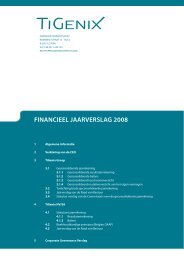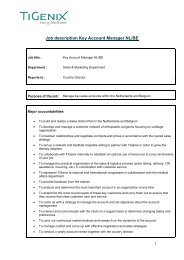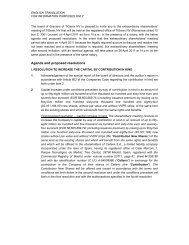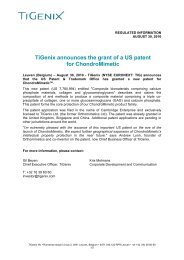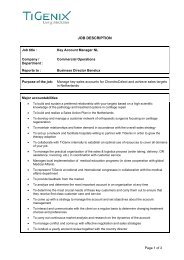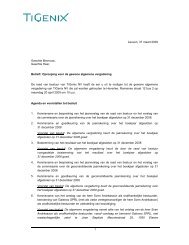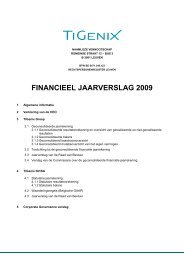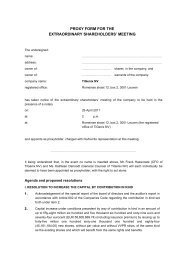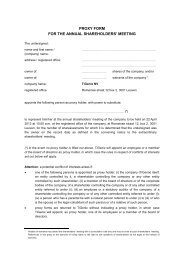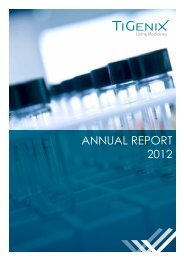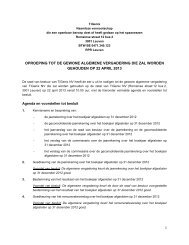ANNUAL FINANCIAL REPORT 2010 2010 - TiGenix
ANNUAL FINANCIAL REPORT 2010 2010 - TiGenix
ANNUAL FINANCIAL REPORT 2010 2010 - TiGenix
- No tags were found...
You also want an ePaper? Increase the reach of your titles
YUMPU automatically turns print PDFs into web optimized ePapers that Google loves.
InventoriesInventories are carried at the lower of acquisition cost or netrealisable value. Commercial discounts, rebates obtained, othersimilar items are deducted when determining the acquisitioncost.Cellerix makes the relevant valuation adjustments, recognisingthem as an expense in the statement of comprehensiveincome, when the net realisable value of inventories falls belowtheir acquisition cost.ReceivablesAs a general rule, these accounts receivable do not accrue anyinterest and are presented at their nominal value.Cash and cash equivalentsCash and cash equivalents are carried in the balance sheet atnominal value. For the purposes of the stand-alone cash flowstatements, prepared according to the indirect method, cashand cash equivalents comprise cash on hand and deposits heldwith banks with a maturity date of three months or less.Financial liabilitiesFinancial liabilities are those debts and payable arising from thepurchase of goods or services as part of the company’s tradingactivities, or those arising from non-trading activities but whichare not considered to be derivative financial instruments.Debts and payables are initially stated at the fair value of theconsideration received plus any directly attributable transactioncosts. They are subsequently stated at their amortised cost.Cellerix eliminates financial liabilities from the balance sheetonce the associated obligations are extinguished.Interest bearing loans received from public bodies are recordedat the amount received, net of direct costs associated withthose loans, if applicable. Finance costs, including premiumspayable on settlement or reimbursement and direct costs ofthe issue are recorded on an accrual basis in the comprehensiveincome statement using the effective interest method, and areadded to the booked amount of the instrument, to the extentthat they are not settled during the period in which they areproduced.Trade payablesTrade payables are not interest bearing and are stated at theirnominal value.ProvisionsWhen preparing Cellerix’ financial statements, the directorsdistinguish between:• Provisions: Credit balances covering obligations existing atthe date of the stand-alone balance sheet arising as a resultof past events or contractual obligations, which could resultin future outflows of funds, specific in nature but whoseamount and/or reversal date are uncertain, and,• Contingent liabilities: Possible obligations arising as a resultof past events, whose materialisation is dependent on theoccurrence, or otherwise, of one or more future eventsfalling outside the organisation’s control.The financial statements show all provisions for which it isconsidered more likely than not that the obligation will have tobe met. In respect of contingent liabilities, not being derivedfrom any business activity, they are not recognised and aredetailed in the notes to the stand-alone financial statements.Income tax; deferred tax assets and liabilitiesCorporate income tax expense is calculated by adding thecurrent tax yielded by applying the tax rate to the taxableincome for the year and after applying the admissible taxdeductions, to the variation in deferred tax assets and liabilities.Deferred tax assets and liabilities include timing differences,which are identified as the expected balances payable orrecoverable as a result of differences in the book value andtax value of assets and liabilities, as well as tax losses pendingcarry forward and credits for tax deductions not applied. Theseamounts are recorded applying to the timing difference orcredit in question the tax rate at which they are expected to becollected or settled.Deferred tax liabilities are recognised for all taxable timingdifferences, except those in which the timing difference derivesfrom the initial recognition of other assets and liabilities inoperations that affect neither tax income nor accountingincome.On the other hand, deferred tax assets, identified with timingdifferences, are only recorded when it is considered likely thatCellerix will have sufficient future taxable earnings againstwhich they can be applied and provided they do not arise fromthe initial recognition of other assets and liabilities in operationsthat affect neither tax income nor accounting income. Theremaining deferred tax assets (tax losses and deductionspending carry forward) are only recorded when it is consideredthat Cellerix will probably have sufficient tax earnings in the206 • <strong>TiGenix</strong> • Rights Offering



